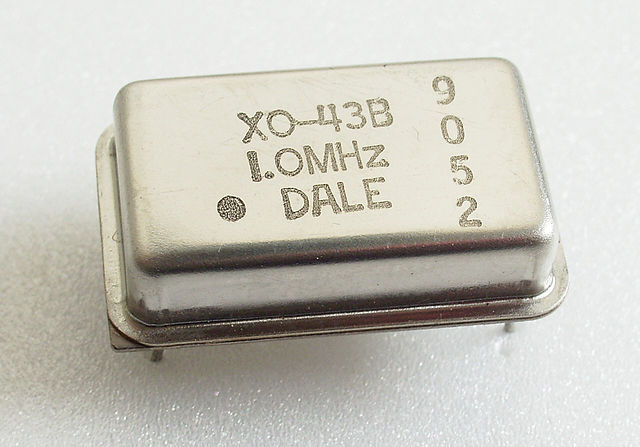| Vocademy |
Miscellaneous Components
Circuit protection devices
Fuses

Fuses are designed to melt open when a certain current is exceeded. Usually, a fuse will “blow” when the current reaches 1.5 times the labeled current rating. Although they are thought of as protecting a circuit from excess current they equally protect power supplies from the effects of a shorted load.

| A glass cylinder fuse used in electronic equipment and older automobiles. |

| Modern automobile fuses. |
Since fuses protect a circuit from excessive current they are installed in series with the load.
Circuit breakers
A circuit breaker is a resettable fuse. A circuit breaker may look like a toggle switch or have a push button that pops out when triggered. Many circuit breakers are thermally triggered. They have a heating element that triggers a thermal switch when too much current passes through them.Another device that is called a thermistor fuse is actually a resettable fuse that develops a very high resistance when it gets hot. Once it cools down it begins to conduct normally again.
Metal Oxide Varistor (MOV)
 |
|
| An MOV |
| |
 |
|
| Industrial MOV |
| |
|
  |
| Schematic symbols (top is obsolete) |
An MOV protects a circuit from excess voltage for short periods. An MOV looks like an open circuit at low voltages but loos like a short circuit above a specific voltage called the clamping voltage. This prevents the voltage from going high enough to damage the circuit. For example, inexpensive surge protectors use MOVs to absorb power surges.
An MOV is like an automatic toilet flusher (stay with me here). If you flush the toilet while someone is taking a shower, they get an unpleasant surprise. This is because the pipe supplying water to the house can only provide so much water. If you try to use more water than the service pipe can deliver, something has to give. What gives is pressure. The service pipe offers resistance to water flow, so there is a lower pressure where the water exits the pipe than where it enters the pipe. This is just like current flowing through an output impedance to a load. More current through a high impedance means more voltage drop (see Impedance Matching). The cold water entering the house through the service pipe loses pressure when you demand too much flow, but the water heater acts as a reservoir and continues to supply hot water at a usable pressure. Therefore, hot water continues to flow to the shower at a usable rate, but the cold water flow drops.
Let's say you want to protect the pipes in the house in case the pressure
from the service pipe goes too high momentarily. If you automatically flush
the toilet when this happens, there will be more demand than the service
pipe can deliver, bringing the pressure back down.
Likewise, there is a limit to how much current can be supplied by the wiring
to your electrical outlet. If you demand more current than can be delivered,
something has to give. What gives is voltage. An MOV will demand a large
amount of current if the voltage rises above the clamping voltage. Demanding
this current through the relatively high impedance of the power grid brings
the voltage back down. The current passed through an MOV while it is
absorbing a power surge may be much greater than that allowed by the circuit
breaker[1].
However, MOVs act on voltage transients much too short for a circuit breaker
to react.
An MOV can only work for short-duration power surges. This is because the
high current will trip the circuit breaker if the MOV remains in its low
impedance state too long. Also, an MOV can only withstand a high current for
a few microseconds without damage.
MOVs degrade as they absorb voltage surges. They often are coated with a
material that changes color as they degrade, so you can know when they will
no longer work.
An MOV is used for over-voltage or "surge" protection and is therefore
connected in parallel with the load. Power strips with surge protection
usually contain MOVs.
MOV Failure
If an MOV is exposed to a long-duration power surge, it may fail, becoming an open circuit. If so, it is no longer protecting the circuit. Some MOVs have a color-changing coating that indicates if the MOV became hot enough to be damaged (e.g., changing from green to brown). Such MOVs may be visible through a window in the circuit enclosure so their status can be monitored. MOVs may have a fuse wired in series. This fuse is expected to blow if enough current passes for a long enough time to damage the MOV. This cuts power to the circuit if the MOV may have been damaged. Thermal fuses are often attached to MOVs and wired in series. These cut power to the circuit if the MOV becomes hot enough to be damaged. MOVs manufactured with integral thermal protection are called TMOVs.
Thermoelectric devices
Thermistor
A thermistor is a resistor that changes resistance when its temperature changes. They are used to measure temperature. Actually, all resistors are temperature-sensitive but a thermistor is manufactured to change at a specified rate. |
 |
 |
| Thermistor schematic symbols. The symbol to the left is obsolete. The middle and right symbols indicate a positive temperature coefficient. |
There are two types of thermistors. A thermistor with a positive temperature coefficient has its resistance increase when the temperature increases. A thermistor with a negative temperature coefficient has its resistance decrease when the temperature increases.
Thermocouple

| Thermocouple schematic symbol |
When two dissimilar metals are bonded together they generate a voltage that varies with temperature, forming a thermocouple. Thermocouples are used to measure high temperatures where other temperature sensors would be destroyed. A typical thermocouple will have an output of a few millivolts. Thermocouples are used in nuclear-powered thermoelectric generators (radioisotope thermoelectric generators or RTGs). Certain elements, such as Plutonium-238 (238Pu) produce heat from radioactive decay. In an RTG such a mass is surrounded by thermocouples that convert the heat directly into electricity. They can only achieve an efficiency of about 3-7% so are only used where no other power source is practical. RTGs have been used in spacecraft that traveled too far from the sun to use solar power and by the Soviet Union for unmanned lighthouses near the arctic circle.
Peltier device

| A Peltier Device |
A Peltier device forms a temperature gradient when a voltage is placed across it, meaning it gets cold on one side and hot on the other (transferring heat from the cold side to the hot side). One common use for a Peltier device is refrigerator/heater chests for camping. They are also used in computers to help transfer heat from integrated circuits (usually the CPU) to heat sinks. A typical Peltier device develops a temperature differential of approximately 22°C (40°F) at its rated current with good heat dissipation (to work efficiently a Peltier device needs large heat sinks with fans on both sides).
Thermal fuses

| Typical small thermal fuses used in home appliences |
A thermal fuse is designed to open above a certain temperature. This acts like a regular fuse except it operates on temperature instead of current. In home appliances (e.g. coffee makers) thermal fuses are often used in pairs wired in series. This is because regulations (UL listing standards) allow the use of two low cost, low reliability fuses in place of a single higher cost higher reliability fuse (UL 1082). If either fuse opens the circuit is broken because the fuses are wired in series.
Photoelectric devices
Photovoltaic cells (solar cells)
A photovoltaic cell, also known as a solar cell, solar battery (occasionally photocell46), converts light directly into electrical potential (voltage).
| A silicon photovoltaic cell |
Photovoltaic cells are used anywhere from small devices to simply detect light, to small battery chargers and large panels to produce electricity on an industrial scale. A typical silicon photovoltaic cell produces about 0.5 volts. The available current depends on the size, efficiency and amount of light energy falling on the cell.
Photoresistor
A photoresistor or photocell1 changes resistance depending on the amount of light falling upon it. Like photovoltaic cells, photoresistors are sometimes called photocells. The common cadmium sulfide (CdS) photoresistor has less resistance when it receives more light.
| A cadmium sulfide photoresistor |
The CdS photoresistor is commonly used in devices that turn on when it gets dark or otherwise need to sense changes in light level.
Photodiodes and phototransistors
Photodiodes and phototransistors are semiconductor devices that change their conductivity when the amount of light falling on them changes. They are more sensitive and respond faster than CdS photoresistors. They are discussed in detail in the volume on solid state devices.Hall effect sensors
A Hall effect sensor is usually a solid state device that is sensitive to magnetic fields. They essentially act like variable resistors with a resistance that varies with the strength of a magnetic field.Crystals and piezoelectricity
Crystals made from quartz and other materials are frequently used in electronics. When a crystal is physically distorted it develops an electric potential (a voltage difference develops across it). Also, when an electric potential is applied across a crystal, the crystal will bend. This is called the piezoelectric effect.Crystals can be used as transducers that convert mechanical energy to electrical energy or vice versa. Crystal strain gauges can measure mechanical force. They are used in weight scales and accelerometers for example.
Many cigarette lighters and stoves use a device that strikes a crystal with a spring-loaded hammer to generate a spark to ignite a flammable gas.

| The igniter from a cigarette lighter. When the square plunger at the
lower left is depressed it cocks and releases a spring-loaded hammer.
The hammer strikes a crystal causing a spark between the electrodes at
the upper right. |
Crystals are also used as microphones and speakers where they turn the vibrations of sound into varying voltage or current and vice versa. Practical crystal speakers work at high frequencies so tweeters are often crystal speakers. Crystal microphones and earphones don't need to move large volumes of air. They can work efficiently at the full range of sound frequencies.[2] Crystal earphones typically have poor bass response but can be made with to respond evenly to all audio frequencies. Crystal speakers and microphones are usually used where high sensitivity and high impedance is needed. Early crystal speakers and microphones were made from rochelle salt (Potassium sodium tartrate tetrahydrate). Rochell salt degrades in damp conditions. Modern devices are usually made with barium titanate and occasionally quartz.
Piezoelectric cooling fans are made of thin slabs of crystal material that are made to "flap" back and forth to produce air currents.
A crystal cut to a precise size will vibrate at a specific frequency when stimulated with electric pulses. Such crystals can provide an accurate time base for oscillators or can act as filters to screen radio signals.[3]

| A crystal for a citizen's band radio transmitter. This crystal is for 26.965 MHz, channel 1. |
These crystals are typically made from precisely ground thin slabs of quartz mounted between two plates of metal.

| Inside a crystal enclosure like the one above. The electrodes are printed with conductive ink on opposite sides of the crystal slab. |
Crystal oscillators are universally used in digital devices from watches to computers.

| A typical crystal used for digital circuits. |
The pulses from these oscillators cause the digital circuits to perform their functions.
 |
|
| A complete crystal oscillator circuit designed for digital circuits. |
| |
|
| Inside the oscillator circuit. The crystal is the disc in the upper left. The electrodes are printed on opposite sides of the the crystal with conductive ink. |
Miscellaneous Components
—————————
| Vocademy |
